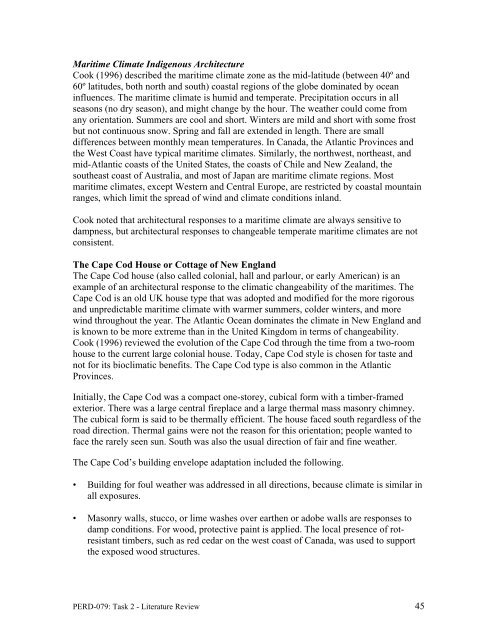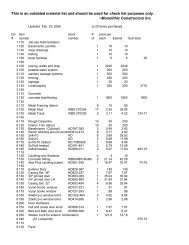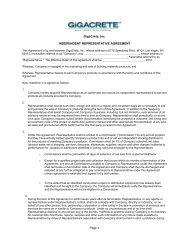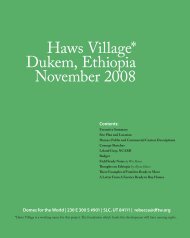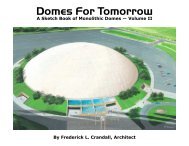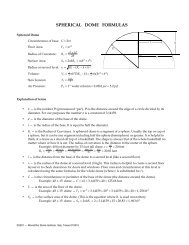Literature Review on Building Envelope, Heating and ... - Beeshive.org
Literature Review on Building Envelope, Heating and ... - Beeshive.org
Literature Review on Building Envelope, Heating and ... - Beeshive.org
You also want an ePaper? Increase the reach of your titles
YUMPU automatically turns print PDFs into web optimized ePapers that Google loves.
Maritime Climate Indigenous Architecture<br />
Cook (1996) described the maritime climate z<strong>on</strong>e as the mid-latitude (between 40º <strong>and</strong><br />
60º latitudes, both north <strong>and</strong> south) coastal regi<strong>on</strong>s of the globe dominated by ocean<br />
influences. The maritime climate is humid <strong>and</strong> temperate. Precipitati<strong>on</strong> occurs in all<br />
seas<strong>on</strong>s (no dry seas<strong>on</strong>), <strong>and</strong> might change by the hour. The weather could come from<br />
any orientati<strong>on</strong>. Summers are cool <strong>and</strong> short. Winters are mild <strong>and</strong> short with some frost<br />
but not c<strong>on</strong>tinuous snow. Spring <strong>and</strong> fall are extended in length. There are small<br />
differences between m<strong>on</strong>thly mean temperatures. In Canada, the Atlantic Provinces <strong>and</strong><br />
the West Coast have typical maritime climates. Similarly, the northwest, northeast, <strong>and</strong><br />
mid-Atlantic coasts of the United States, the coasts of Chile <strong>and</strong> New Zeal<strong>and</strong>, the<br />
southeast coast of Australia, <strong>and</strong> most of Japan are maritime climate regi<strong>on</strong>s. Most<br />
maritime climates, except Western <strong>and</strong> Central Europe, are restricted by coastal mountain<br />
ranges, which limit the spread of wind <strong>and</strong> climate c<strong>on</strong>diti<strong>on</strong>s inl<strong>and</strong>.<br />
Cook noted that architectural resp<strong>on</strong>ses to a maritime climate are always sensitive to<br />
dampness, but architectural resp<strong>on</strong>ses to changeable temperate maritime climates are not<br />
c<strong>on</strong>sistent.<br />
The Cape Cod House or Cottage of New Engl<strong>and</strong><br />
The Cape Cod house (also called col<strong>on</strong>ial, hall <strong>and</strong> parlour, or early American) is an<br />
example of an architectural resp<strong>on</strong>se to the climatic changeability of the maritimes. The<br />
Cape Cod is an old UK house type that was adopted <strong>and</strong> modified for the more rigorous<br />
<strong>and</strong> unpredictable maritime climate with warmer summers, colder winters, <strong>and</strong> more<br />
wind throughout the year. The Atlantic Ocean dominates the climate in New Engl<strong>and</strong> <strong>and</strong><br />
is known to be more extreme than in the United Kingdom in terms of changeability.<br />
Cook (1996) reviewed the evoluti<strong>on</strong> of the Cape Cod through the time from a two-room<br />
house to the current large col<strong>on</strong>ial house. Today, Cape Cod style is chosen for taste <strong>and</strong><br />
not for its bioclimatic benefits. The Cape Cod type is also comm<strong>on</strong> in the Atlantic<br />
Provinces.<br />
Initially, the Cape Cod was a compact <strong>on</strong>e-storey, cubical form with a timber-framed<br />
exterior. There was a large central fireplace <strong>and</strong> a large thermal mass mas<strong>on</strong>ry chimney.<br />
The cubical form is said to be thermally efficient. The house faced south regardless of the<br />
road directi<strong>on</strong>. Thermal gains were not the reas<strong>on</strong> for this orientati<strong>on</strong>; people wanted to<br />
face the rarely seen sun. South was also the usual directi<strong>on</strong> of fair <strong>and</strong> fine weather.<br />
The Cape Cod’s building envelope adaptati<strong>on</strong> included the following.<br />
• <strong>Building</strong> for foul weather was addressed in all directi<strong>on</strong>s, because climate is similar in<br />
all exposures.<br />
• Mas<strong>on</strong>ry walls, stucco, or lime washes over earthen or adobe walls are resp<strong>on</strong>ses to<br />
damp c<strong>on</strong>diti<strong>on</strong>s. For wood, protective paint is applied. The local presence of rotresistant<br />
timbers, such as red cedar <strong>on</strong> the west coast of Canada, was used to support<br />
the exposed wood structures.<br />
PERD-079: Task 2 - <str<strong>on</strong>g>Literature</str<strong>on</strong>g> <str<strong>on</strong>g>Review</str<strong>on</strong>g> 45


